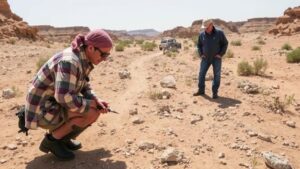Spotting Evidence of Ritual Gatherings in Hidden Canyon Groves
Spotting Evidence of Ritual Gatherings in Hidden Canyon Groves
Hidden canyon groves are often significant locales for Native American civilizations and other ancient societies, serving as sites for rituals, ceremonies, and communal gatherings. Understanding how to identify and interpret evidence of past ritualistic activities can offer profound insights into these cultures and their social practices. This article delves into the various types of evidence that indicate ritual gatherings in hidden canyon groves, including archaeological findings, ecological markers, and cultural artifacts.
Archaeological Findings
Archaeological evidence is one of the most concrete ways to identify past ritual gatherings in hidden canyon groves. Excavations often reveal remnants such as fire pits, ceremonial altars, and storage features that hint at communal activities.
- Fire Pits: The presence of fire pits can suggest locations where groups gathered for ceremonial purposes. For example, in the Chaco Canyon area of New Mexico, researchers discovered large, circular fire features that likely hosted fire ceremonies linked to ancient agricultural practices.
- Ceremonial Altars: Elevated structures found within groves may serve as altars where offerings were made. Such altars often have surrounding stone arrangements that indicate specific ritualistic patterns. A case study in central Arizona reveals stone configurations around a grove believed to be a ceremonial site used by the Hohokam culture.
These archaeological markers are not only telling of the activities that occurred, but can also lead researchers to uncover more about the community’s spiritual life and social hierarchy.
Ecological Indicators
Ecosystems within hidden canyon groves can provide clues regarding ritual practices. Certain plants might be intentionally cultivated or preserved due to their ceremonial significance. For example, the presence of specific medicinal plants, such as sage or white sage, may suggest a connection to purification rituals.
- Plant Selections: Certain groves may feature vegetation patterns that indicate selective gathering or planting for rituals. Ethnobotanical studies reveal that specific plants served dual purposes as both culinary resources and items used in ceremonial contexts, underscoring the deep relationship between culture and nature.
- Animal Remains: Faunal remains found in these areas can tie into various rituals based on species and how they were processed. For example, the discovery of turkey bones can indicate fowl was used in rituals related to fertility and harvests, particularly among tribes in the Southwestern United States.
These ecological indicators emphasize how the natural environment was integral to ritual practices, providing insights into the cultural values underpinning them.
Cultural Artifacts and Symbolism
Cultural artifacts, such as pottery fragments, rock art, and ceremonial regalia, often serve as potent evidence of ritual gatherings. The symbolism embedded in these artifacts provides a window into the beliefs and practices of the people.
- Pottery and Artifacts: Surface surveys in hidden canyon groves can reveal pottery shards that carry specific iconography. For example, certain designs may signify cosmological beliefs that guided rituals. The Hopi tribe, known for their intricate pottery, often embeds symbols related to water and fertility, fundamental themes in their ritual traditions.
- Rock Art: Petroglyphs and pictographs embedded in the canyon walls may depict scenes of rituals or deities worshipped. For example, the rock art found in Canyon de Chelly depicts kachina dancers that are integral to spiritual practices among the Pueblo peoples.
These artifacts highlight how ancient peoples expressed their spirituality and cultural narratives through tangible forms, illuminating their complex relationship with the world around them.
Real-World Applications
Understanding how to spot and interpret evidence of ritual gatherings in hidden canyon groves has significant implications for anthropology, archaeology, and conservation. Researchers can better understand historical patterns, which can inform current cultural practices and heritage preservation efforts.
Also, the identification of these sites contributes to a greater understanding within the context of contemporary indigenous community rights. Documenting these locations helps acknowledge their cultural significance and can aid in environmental conservation strategies that benefit both the ecosystem and its native traditions.
Actionable Takeaways
- Engage in field studies within hidden canyon groves, paying attention to archaeological features and ecological markers.
- Collaborate with local indigenous communities to gain insights into traditional knowledge and practices related to ritual gatherings.
- Use technological advancements, such as drone surveys or GIS mapping, to enhance site identification and analysis.
- Incorporate findings into broader discussions about cultural preservation and environmental stewardship.
To wrap up, spotting evidence of ritual gatherings in hidden canyon groves requires a multidisciplinary approach, blending archaeology, ecology, and anthropology. By examining diverse indicators and respecting cultural narratives, we can enrich our understanding of these historically significant locations.


